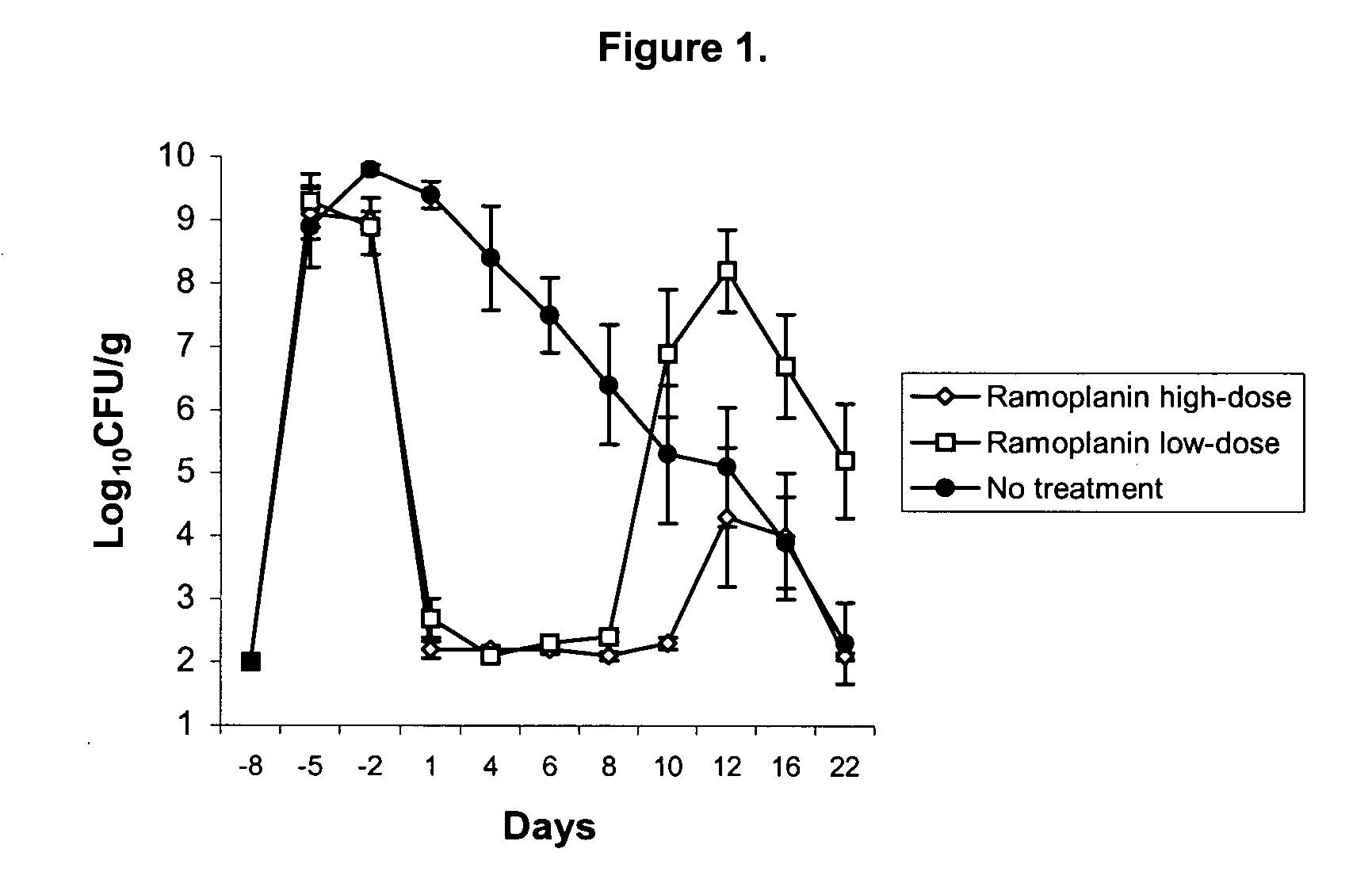Methods for reducing or preventing transmission of nosocomial pathogens in a health care facility
a nosocomial pathogen and health care facility technology, applied in the field of mammalian pathogenic infections, can solve problems such as the risk of colonization, and achieve the effect of reducing or preventing the transmission of pathogens to uncolonized individuals and reducing the endemic ra
- Summary
- Abstract
- Description
- Claims
- Application Information
AI Technical Summary
Benefits of technology
Problems solved by technology
Method used
Image
Examples
example 1
Suppression of VRE in a Mouse Model Mice were colonized with a clinical isolate VanA strain of E. faecium (VRE) isolated from a septicemic patient. A single inoculation of 5×108 cfu VRE by oral gavage (Day 0) was followed by treatment with vancomycin in the drinking water to maintain colonization. On day 22, each group received the same vancomycin-containing drinking water. One group also received ramoplanin (100 μg / mL) in its drinking water. The dose of ramoplanin per day was estimated to be 15 mg / kg, based on a standard water consumption of 150 mL / kg / day. Treatment with ramoplanin was discontinued on Day 29, and vancomycin treatment was discontinued on Day 36. The control group consisted of five mice, while the ramoplanin group consisted of four mice.
[0071] Treatment with ramoplanin significantly reduced the faecal density and carriage of VRE in mice. After one week of treatment, the VRE concentration per gram of faeces fell from 9.7 log units to an undetectable level (<3.1 log u...
example 2
Efficacy of Ramoplanin for Eradication of VRE Colonization
[0072] Pathogens Studied: E. faecium C68, a previously described VanB-type clinical VRE isolate, was used for the following murine VRE experiments (Donskey et al., J. Microbiol. Meth. 1807: 1-8, 2003). The minimum-inhibitory concentration of ramoplanin for VRE C68 was 0.125 μg / mL. Klebsiella pneumoniae P62 is a clinical isolate that produces an SHV type extended-spectrum β-lactamase (ESBL). Candida glabrata A239 is a clinical isolate with a fluconazole minimum-inhibitory concentration of 2 μg / mL.
[0073] Quantification of Stool Pathogens: Fresh stool specimens were processed as described by Donskey et al. (supra). In order to quantify VRE, K. pneumoniae, and C. glabrata, diluted samples were plated onto Enterococcosel agar containing vancomycin 20 μg / mL, MacConkey agar containing ceftazidime 10 μg / mL, or Sabouraud Dextrose Agar (Becton, Dickinson, and Company, Sparks, Md.) containing piperacillin / tazobactam 16 μg / mL and linez...
example 3
Effect of Ramoplanin on the Indigenous Stool Microflora
[0078] Female CF1 mice (Harlan Sprague-Dawley, Indianapolis) weighing 25-30 g were used in these experiments. In order to minimize the risk of cross-contamination, mice were housed in individual cages with plastic filter tops. Five mice were treated with ramoplanin 100 μg / mL in drinking water for 7 days. Stool samples were collected prior to treatment, on day 7 of treatment, and 3, 6, and 11 days after discontinuation of ramoplanin. Quantitative cultures for facultative and aerobic gram-negative bacilli, enterococci, total anaerobes, Bacteroides species, Lactobacillus species, and Clostridium species were performed by plating serially-diluted specimens onto MacConkey agar (Difco Laboratories, Detroit), Enterococcosel agar (Becton Dickinson, Cockeysville, Md.), Brucella agar (Becton Dickinson), Bacteroides bile esculin agar, Rogosa agar, and Egg Yolk agar, respectively. For culture of anaerobes, stool samples were processed insi...
PUM
| Property | Measurement | Unit |
|---|---|---|
| time | aaaaa | aaaaa |
| minimum-inhibitory concentration | aaaaa | aaaaa |
| minimum-inhibitory concentration | aaaaa | aaaaa |
Abstract
Description
Claims
Application Information
 Login to View More
Login to View More - R&D
- Intellectual Property
- Life Sciences
- Materials
- Tech Scout
- Unparalleled Data Quality
- Higher Quality Content
- 60% Fewer Hallucinations
Browse by: Latest US Patents, China's latest patents, Technical Efficacy Thesaurus, Application Domain, Technology Topic, Popular Technical Reports.
© 2025 PatSnap. All rights reserved.Legal|Privacy policy|Modern Slavery Act Transparency Statement|Sitemap|About US| Contact US: help@patsnap.com

